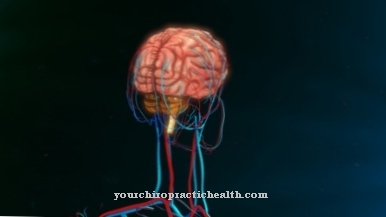Of the Triceps tendon reflex belongs to the reflexes. When the tendon of the triceps muscle is hit, the muscle contracts.A weakened reflex can indicate a disturbance in segments C6 and C7 or an impairment of the radial nerve.
What is the triceps tendon reflex?

The triceps tendon reflex is also called the TSR or Pocket knife reflex designated. Like the biceps tendon reflex or the patellar tendon reflex, it is one of the self-reflexes. In the case of self-reflexes, both the receiving organ and the organ of success are in the same muscle. In the triceps tendon reflex, this is the triceps muscle.
The triceps muscle is also known as the three-headed upper arm muscle, arm extensor or triceps. It belongs to the group of the upper arm muscles and has its origin in the humerus and shoulder blade. Together with the anconeus muscle, the triceps are responsible for stretching the forearm in the elbow joint. As a result, the triceps tendon reflex causes extension in the elbow joint.
Function & task
The reflex test and thus also the triceps tendon reflex are an integral part of the clinical examination and especially the neurological examination. The examination of the triceps tendon reflex can be carried out on the seated or lying patient. With the patient lying down, the arm is placed on the chest at an angle. If the patient is sitting, the examiner has to hold up his arm so that it is bent in the shoulder joint and bent in the elbow joint.
The reflex is triggered by a short and not too strong blow on the tendon of the triceps brachii muscle. This is just above the so-called olecranon. The olecranon is the end of the ulna near the elbow. A reflex hammer is suitable for the blow. Most hammers have two different sized rubber inserts on the head. The thicker rubber pole is used for the triceps tendon reflex.
The reflex examination is always carried out on both sides so that the reflex response can then be compared. As a rule, the reflex response is divided into categories.
A reflex can be normal, weakened, diminished, increased or absent. There are two clinical scale systems for a more precise classification: The nine-step MayoClinicScale (MCS) and the scale of the National Institute of Neurological Disorders and Stroke are rarely used in everyday practice and clinical practice, as the assignment to the individual scale values varies from examiner to examiner so that comparability is not guaranteed.
If the reflex response appears very weak at first, a reflex path can be carried out. To do this, the patient grabs his teeth firmly or clenches his hands into a fist. Alternatively, the Jendrassik handle can also be used. To do this, the patient bends his arms in front of the upper body and crosses his hands. The examiner now asks the patient to pull his hands apart very forcefully. This creates a pre-tension that sensitizes the muscle fibers of the muscle spindles for stretching.
The reflex then results from an involuntary reaction to the sudden stretching of the muscle spindles by the blow with the reflex hammer. A contraction of the muscle is then triggered via a monosynaptic reflex arc. The triceps tendon reflex is mediated via the motor neurons from segments C6 and C7 and via the radial nerve.
Illnesses & ailments
Accordingly, a weakened or eliminated triceps tendon reflex suggests a disorder in the area of segments C6 and C7 or a lesion of the radial nerve.
The most common cause of damage to the nerve roots in this area is a herniated disc in the cervical spine (cervical spine). In the case of a herniated disc, the gelatinous core of the disc protrudes and presses on the nerves leaving the spinal cord. These are also called spinal nerves. The nerves can also be affected by a bulging disc. The disc protrusion (protrusion) is the preliminary stage of the actual disc herniation (prolapse). A herniated disc manifests itself primarily as acute pain. The pain has a stabbing character and can radiate. In the case of a herniated disc in the C6 and C7 area, the pain typically radiates to the arm. Often there are also sensory disorders such as numbness or tingling. Muscle weakening is also possible. Symptoms are exacerbated by coughing and sneezing.
A lesion of the radial nerve also affects the triceps tendon reflex. The spoke nerve is one of the nerves of the arm nerve plexus. Among other things, it innervates the triceps brachii muscle. A weakened or abolished triceps tendon reflex occurs especially with an upper radial paralysis. This means damage to the radial nerve in the armpit area. Often this is caused by crutches. This is why one speaks of crutch paralysis. However, a plaster cast or trauma, such as a fracture of the humerus head, can also cause superior radial paralysis.
Due to the paralysis of the triceps muscle, the forearm can no longer be stretched. The triceps tendon reflex is either absent or weakened. A drop hand and drop finger can also be seen. This means that finger joints and wrists can no longer be stretched either.
With the help of the triceps tendon reflex, crutch paralysis can be distinguished from park bench paralysis. In the so-called park bench paralysis, there is moderate radial paralysis. This is caused by prolonged pressure. The radial nerve can be damaged if the arm rests on a hard surface for a long time or if a plaster cast does not fit properly. Damage can also occur after fractures of the humerus. In contrast to crutch paralysis, park bench paralysis does not affect the triceps tendon reflex, since the nerve fibers for the triceps muscle originate above the lesion site.













.jpg)

.jpg)
.jpg)











.jpg)